[精品]2019学年高二英语下学期第三次月考试题(含解析)人教版(1)
【高二】高二英语下册第三次月考试题(带参考答案)
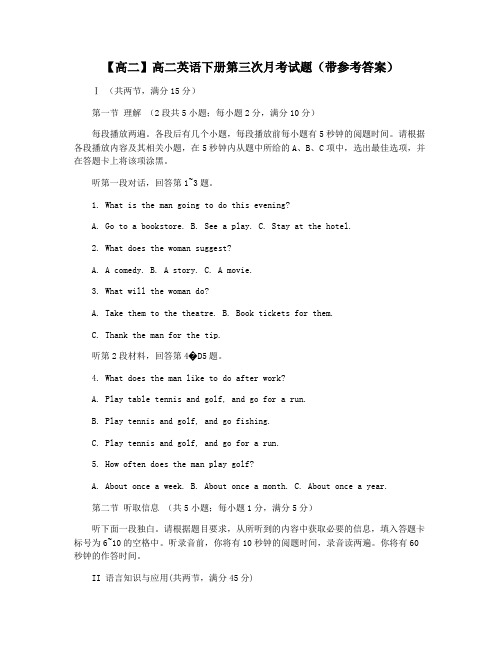
【高二】高二英语下册第三次月考试题(带参考答案)Ⅰ (共两节,满分15分)第一节理解(2段共5小题;每小题2分,满分10分)每段播放两遍。
各段后有几个小题,每段播放前每小题有5秒钟的阅题时间。
请根据各段播放内容及其相关小题,在5秒钟内从题中所给的A、B、C项中,选出最佳选项,并在答题卡上将该项涂黑。
听第一段对话,回答第1~3题。
1. What is the man going to do this evening?A. Go to a bookstore.B. See a play.C. Stay at the hotel.2. What does the woman suggest?A. A comedy.B. A story.C. A movie.3. What will the woman do?A. Take them to the theatre.B. Book tickets for them.C. Thank the man for the tip.听第2段材料,回答第4�D5题。
4. What does the man like to do after work?A. Play table tennis and golf, and go for a run.B. Play tennis and golf, and go fishing.C. Play tennis and golf, and go for a run.5. How often does the man play golf?A. About once a week.B. About once a month.C. About once a year.第二节听取信息(共5小题;每小题1分,满分5分)听下面一段独白。
请根据题目要求,从所听到的内容中获取必要的信息,填入答题卡标号为6~10的空格中。
听录音前,你将有10秒钟的阅题时间,录音读两遍。
2019年最新年新 人教版高二年级英语第三次月考试卷
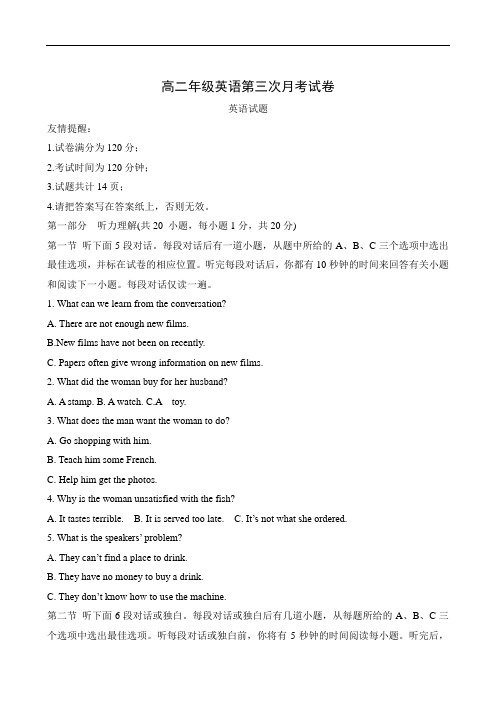
高二年级英语第三次月考试卷英语试题友情提醒:1.试卷满分为120分;2.考试时间为120分钟;3.试题共计14页;4.请把答案写在答案纸上,否则无效。
第一部分听力理解(共20 小题,每小题1分,共20分)第一节听下面5段对话。
每段对话后有一道小题,从题中所给的A、B、C三个选项中选出最佳选项,并标在试卷的相应位置。
听完每段对话后,你都有10秒钟的时间来回答有关小题和阅读下一小题。
每段对话仅读一遍。
1. What can we learn from the conversation?A. There are not enough new films.B.New films have not been on recently.C. Papers often give wrong information on new films.2. What did the woman buy for her husband?A. A stamp.B. A watch.C.A toy.3. What does the man want the woman to do?A. Go shopping with him.B. Teach him some French.C. Help him get the photos.4. Why is the woman unsatisfied with the fish?A. It tastes terrible.B. It is served too late.C. It’s not what she ordered.5. What is the speakers’ problem?A. They can’t find a place to drink.B. They have no money to buy a drink.C. They don’t know how to use the machine.第二节听下面6段对话或独白。
2019-2020年高二下学期第三次月考英语试题 含答案(I)
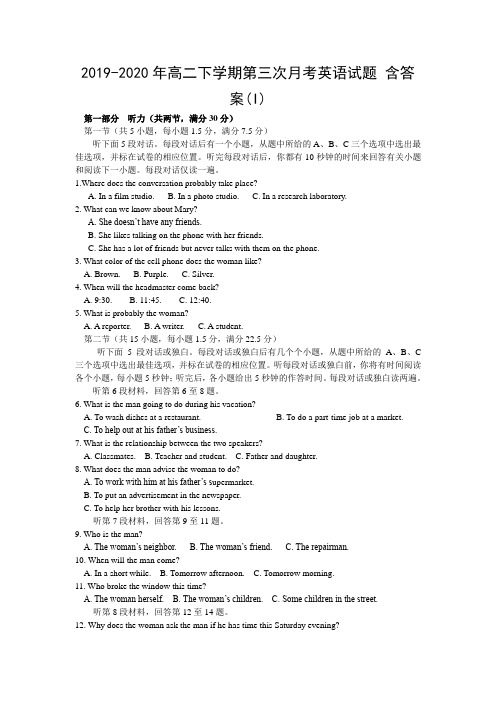
2019-2020年高二下学期第三次月考英语试题含答案(I)第一部分听力(共两节,满分30分)第一节(共5小题,每小题1.5分,满分7.5分)听下面5段对话。
每段对话后有一个小题,从题中所给的A、B、C三个选项中选出最佳选项,并标在试卷的相应位置。
听完每段对话后,你都有10秒钟的时间来回答有关小题和阅读下一小题。
每段对话仅读一遍。
1.Where does the conversation probably take place?A. In a film studio.B. In a photo studio.C. In a research laboratory.2. What can we know about Mary?A. She doesn’t have any friends.B. She likes talking on the phone with her friends.C. She has a lot of friends but never talks with them on the phone.3. What color of the cell phone does the woman like?A. Brown.B. Purple.C. Silver.4. When will the headmaster come back?A. 9:30.B. 11:45.C. 12:40.5. What is probably the woman?A. A reporter.B. A writer.C. A student.第二节(共15小题,每小题1.5分,满分22.5分)听下面5段对话或独白。
每段对话或独白后有几个个小题,从题中所给的A、B、C 三个选项中选出最佳选项,并标在试卷的相应位置。
听每段对话或独白前,你将有时间阅读各个小题,每小题5秒钟;听完后,各小题给出5秒钟的作答时间。
精品2019届高三英语第三次月考试题新人教版 新 版
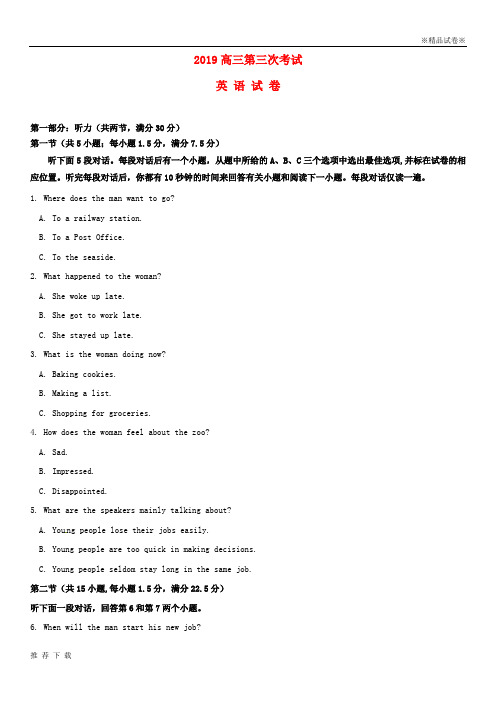
2019高三第三次考试英语试卷第一部分:听力(共两节,满分30分)第一节(共5小题;每小题1.5分,满分7.5分)听下面5段对话。
每段对话后有一个小题,从题中所给的A、B、C三个选项中选出最佳选项,并标在试卷的相应位置。
听完每段对话后,你都有10秒钟的时间来回答有关小题和阅读下一小题。
每段对话仅读一遍。
1. Where does the man want to go?A. To a railway station.B. To a Post Office.C. To the seaside.2. What happened to the woman?A. She woke up late.B. She got to work late.C. She stayed up late.3. What is the woman doing now?A. Baking cookies.B. Making a list.C. Shopping for groceries.4. How does the woman feel about the zoo?A. Sad.B. Impressed.C. Disappointed.5. What are the speakers mainly talking about?A. You ng people lose their jobs easily.B. Young people are too quick in making decisions.C. Young people seldom stay long in the same job.第二节(共15小题,每小题1.5分,满分22.5分)听下面一段对话,回答第6和第7两个小题。
6. When will the man start his new job?A. Tomorrow.B. Next week.C. Next month.7. Why is the man paying for the woman’s lunch?A. She helped him a lot.B. It i s his turn to pay.C. He wants to congratulate her.听下面一段对话,回答第8至第10三个小题。
[精品]2019学年高二英语下学期第三次月考试题(含解析)人教版(1)
![[精品]2019学年高二英语下学期第三次月考试题(含解析)人教版(1)](https://img.taocdn.com/s3/m/d2e1d15dbed5b9f3f80f1c5d.png)
2019学年第二学期高三第一次月考英语试题第一部分:英语听力(共两节,共20小题;每小题1.5分,满分30分。
)第一节(共5小题;每小题1.5分,满分7.5分)听下面5段对话。
每段对话后有一个小题,从题中所给的A、B、C三个选项中选出最佳选项,并标在试卷的相应位置。
听完每段对话后,你都有10秒钟的时间来回答有关小题和阅读下一小题。
每段对话仅读一遍。
1. What does the man want the woman to do?A. Look at the planes.B. Listen to some music.C. Stop playing such loud music. 2. What is the probable relationship between the speakers?A. Co-workers.B. Teacher and studentC. Salesman and customer.3. Where will the boy probably go next?A. To his bedroom.B. To the bathroom.C. To his classroom.4. What did the man forget to do?A. Take out the garbage.B. Get some noodles for dinner.C. Buy some things for breakfast.5. Where does the conversation probably take place?A. At a library.B. At a bookstore.C. At a grocery store.第二节(共15小题;每小题1.5分, 满分22.5分) 听下面5段对话或独白。
每段对话或独白后有几个小题,从题中所给的A、B、C三个选项中选出最佳选项。
高二英语下学期第三次月考试题(含解析)
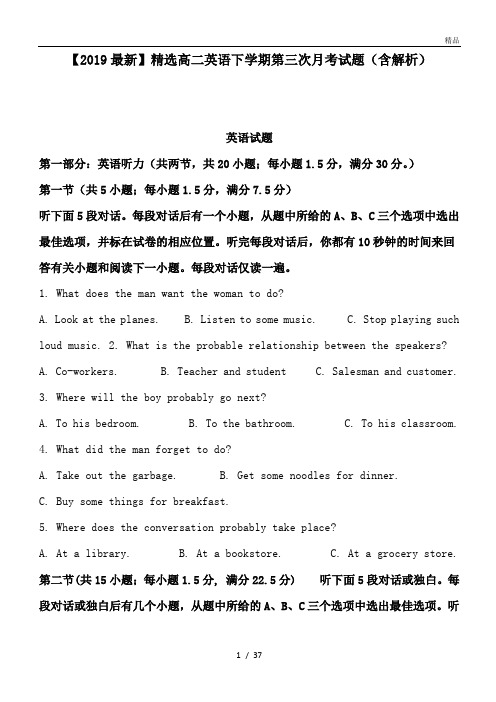
【2019最新】精选高二英语下学期第三次月考试题(含解析)英语试题第一部分:英语听力(共两节,共20小题;每小题1.5分,满分30分。
)第一节(共5小题;每小题1.5分,满分7.5分)听下面5段对话。
每段对话后有一个小题,从题中所给的A、B、C三个选项中选出最佳选项,并标在试卷的相应位置。
听完每段对话后,你都有10秒钟的时间来回答有关小题和阅读下一小题。
每段对话仅读一遍。
1. What does the man want the woman to do?A. Look at the planes.B. Listen to some music.C. Stop playing such loud music. 2. What is the probable relationship between the speakers?A. Co-workers.B. Teacher and studentC. Salesman and customer.3. Where will the boy probably go next?A. To his bedroom.B. To the bathroom.C. To his classroom.4. What did the man forget to do?A. Take out the garbage.B. Get some noodles for dinner.C. Buy some things for breakfast.5. Where does the conversation probably take place?A. At a library.B. At a bookstore.C. At a grocery store.第二节(共15小题;每小题1.5分, 满分22.5分) 听下面5段对话或独白。
每段对话或独白后有几个小题,从题中所给的A、B、C三个选项中选出最佳选项。
[精品]2019学年高二英语下学期3月月考试题新人教版
![[精品]2019学年高二英语下学期3月月考试题新人教版](https://img.taocdn.com/s3/m/d84f742376c66137ee0619ed.png)
2019学年高二英语下学期3月月考试题分值:150分时间:120分钟注意事项:本试卷分第I卷(选择题)和第II卷(非选择题)两部分。
请将I卷(选择题)答案涂在答题卡上,第II卷(非选择题)答案用黑色钢笔(作图除外)做在答题卡上,不得出框。
第I卷(选择题共100分)第一部分听力(共两节,满分30分)第一节(共5个小题:每小题1. 5分,满分7. 5分)听下面5段对话。
每段对话后有一道小题,从每题所给的A B C三个选项中选出最佳选项,并标在试卷的相应位置。
听完每段对话后,你都有10秒钟的时间来回答有关小题和阅读下一小题。
每段对话仅读一遍。
1. What does the woman dislike about the dress?A. The style.B. The size.C. The color.2. How will the man send his application?A. By fax.B. By e-mail.C. By post.3. Where are the woman’s glasses?A. In the living room.B. In her office.C. In her hand.4. What are the speakers talking about?A. A task.B. A teacher.C. A movie.5. What does the woman mean?A. Miss Green opens a dancing hall.B. Miss Green is very quiet.C. Miss Green is noisy.第二节请听下面5段对话或独白,选出最佳选项。
请听第6段材料,回答第6、7题。
6. Why does the man make the call?A. To catch a bus.B. To book a flight.C. To hire a bus.7. When should the man get to the airport?A. At 3:00.B. At 4:50.C. At 6:00.请听第7段材料,回答第8、9题8. What does the man offer to do?A. Call the office manager.B. Sign a form.C. Arrange a meeting.9. What should be put in the meeting room?A. The desks.B. The computers.C. The chairs.请听第8段材料,回答第10至12题。
2019年最新年新 人教版高二英语下学期月月考试题
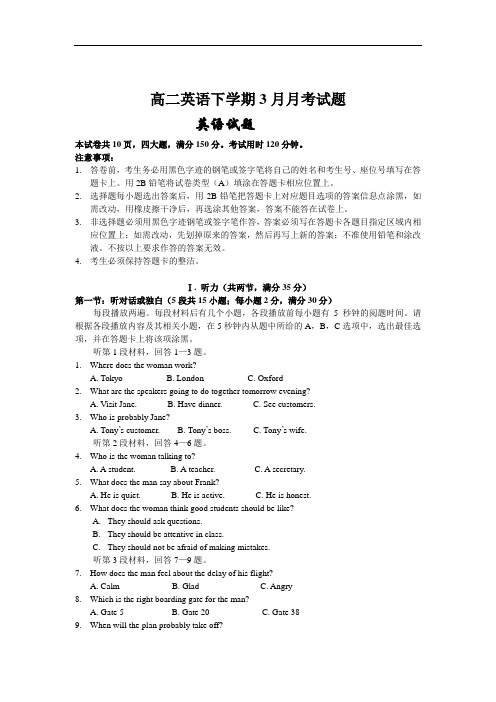
高二英语下学期3月月考试题英语试题本试卷共10页,四大题,满分150分。
考试用时120分钟。
注意事项:1.答卷前,考生务必用黑色字迹的钢笔或签字笔将自己的姓名和考生号、座位号填写在答题卡上。
用2B铅笔将试卷类型(A)填涂在答题卡相应位置上。
2.选择题每小题选出答案后,用2B铅笔把答题卡上对应题目选项的答案信息点涂黑,如需改动,用橡皮擦干净后,再选涂其他答案,答案不能答在试卷上。
3.非选择题必须用黑色字迹钢笔或签字笔作答,答案必须写在答题卡各题目指定区域内相应位置上;如需改动,先划掉原来的答案,然后再写上新的答案;不准使用铅笔和涂改液。
不按以上要求作答的答案无效。
4.考生必须保持答题卡的整洁。
Ⅰ. 听力(共两节,满分35分)第一节:听对话或独白(5段共15小题;每小题2分,满分30分)每段播放两遍。
每段材料后有几个小题,各段播放前每小题有5秒钟的阅题时间。
请根据各段播放内容及其相关小题,在5秒钟内从题中所给的A,B,C选项中,选出最佳选项,并在答题卡上将该项涂黑。
听第1段材料,回答1—3题。
1.Where does the woman work?A. TokyoB. LondonC. Oxford2.What are the speakers going to do together tomorrow evening?A. Visit Jane.B. Have dinner.C. See customers.3.Who is probably Jane?A. Tony’s customer.B. Tony’s boss.C. Tony’s wife.听第2段材料,回答4—6题。
4.Who is the woman talking to?A. A student.B. A teacher.C. A secretary.5.What does the man say about Frank?A. He is quiet.B. He is active.C. He is honest.6.What does the woman think good students should be like?A.They should ask questions.B.They should be attentive in class.C.They should not be afraid of making mistakes.听第3段材料,回答7—9题。
2019学年高二英语下学期第三次学段考试试题 新人教版
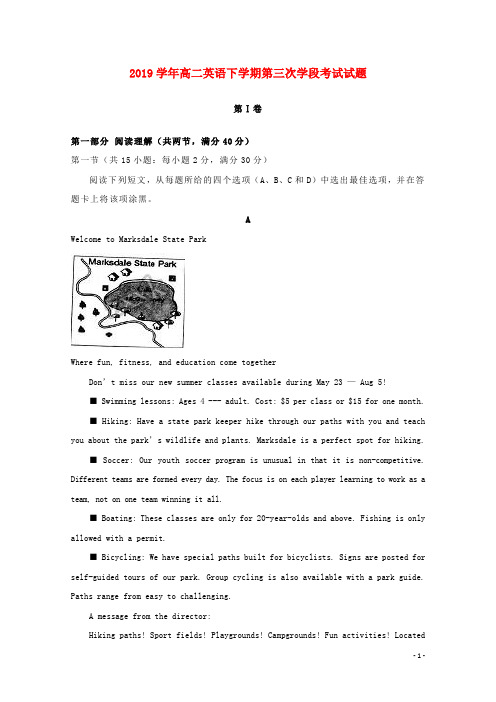
2019学年高二英语下学期第三次学段考试试题第Ⅰ卷第一部分阅读理解(共两节,满分40分)第一节(共15小题:每小题2分,满分30分)阅读下列短文,从每题所给的四个选项(A、B、C和D)中选出最佳选项,并在答题卡上将该项涂黑。
AWelcome to Marksdale State ParkWhere fun, fitness, and education come togetherDon’t miss our new summer classes available during May 23 — Aug 5!■ Swimming lessons: Ages 4 --- adult. Cost: $5 per class or $15 for one month.■ Hiking: Have a state park keeper hike through our paths with you and teach you about the park’s wildlife and plants. Marksdale is a perfect spot for hiking.■ Soc cer: Our youth soccer program is unusual in that it is non-competitive. Different teams are formed every day. The focus is on each player learning to work as a team, not on one team winning it all.■ Boating: These classes are only for 20-year-olds and above. Fishing is only allowed with a permit.■ Bicycling: We have special paths built for bicyclists. Signs are posted for self-guided tours of our park. Group cycling is also available with a park guide. Paths range from easy to challenging.A message from the director:Hiking paths! Sport fields! Playgrounds! Campgrounds! Fun activities! Located(位于) on Lake McQueeney, Marksdale State Park offers something for everyone. We have a number of plants and animals, which are in danger of dying out, being protected in our park. Sign up for one of our new summer community classes, or lake a camping trip with your friends or family. Our facilities (设备) are set up with modem systems, so you don’t have to suffer to enjoy nature --- unless you want to!Glen Harwood, Park DirectorAre you 13-17 years old? Ever wonder what it would be like to be a park keeper? It’s a competitive field, but you can get ahead by volunteering with our Teen Keeper Program. Depending on your age and responsibilities, you can even earn college credits for certain universities!1. If you plan to learn to swim during June and July, you should pay .A. $5B. $15C. $25D. $302. The activities mentioned in the text are available to teenagers EXCEPT .A. swimmingB. boatingC. hikingD. bicycling3. What can we learn about Marksdale State Park?A. Many endangered plants can be found there.B. Special paths will soon be built for bicyclists.C. There are many volunteer programs in the park.D. It is a park full of fun activities and sea animals.4. Where can we most probably read this text?A. In a personal diary.B. In a newspaper report.C. In a travel magazine.D. In a geography textbook.BI went shopping for a dress to wear to my daughte r’s high school graduation halfa year ago. To my horror, I could only fit into a size 20.Being overweight most of my adult life, I always had very little self-confidence. Wearing a dress I didn’t like to such an important event was enough to make me look for help. Thankfully, a friend of mine was attending Weight Watchers meetings, and I noticed her great progress. Her success inspired me to give it a try. I joined Weight Watchers, attended their meetings and started following their Weight-Loss System.I focused on the plan with determination and never missed a weekly meeting! I discovered that I enjoyed the benefits of having the help and support of others. I also read the weekly online e-newsletter and was inspired by the stories, recipes and information offered there, I also read magazines produced by Weight Watchers, which have great tips and new ideas in each issue.It’s hard for me to even remember the person I was before my amazing change.I didn’t walk anywhere and couldn’t wash my car or walk my do g. Today I do these simple tasks without even thinking about them. But the change didn’t happen overnight.I had to exercise with patience and perseverance (坚持). I decided to take it one day at a time and stick with if for good.The “new me” is more self-confident and healthier. I love how I feel now. I have more energy and feel like I’m 25 again. So why not give Weight Watchers a try if you have the same overweight problem?5. The underlined word “inspired” in the second paragraph can be replaced by .A. excitedB. movedC. encouragedD. forced6. We can learn from the passage that the writer .A. often went shopping before she lost weightB. was overweight when she was a childC. ever wanted to give up losing weightD. now is more confident than before7. This passage is written to .A. tell us how to gain self-confidenceB. show off the great progress that the author has madeC. give us some tips on how to lose weight quicklyD. advise overweight people to give Weight Watchers a try8. Which of the following word will you use to describe the writer?A. Weak.B. Calm.C. Patient.D. Silent.CGood music in the life of a child provides many benefits. Music has the ability to change a child’s mind, s oul and body. Because music can create deep feelings andit can have a calming effect on a stressful child. According to many classroom teachers, children perform better under the influence of appropriate music. This is true even for older children. According to the Profiles of the SAT Program, students who take part in music scored much higher on the standardized test than those not involved in a music program.Children can benefit from many types of music. Nursery songs, songs of nature, holiday songs and religious songs all teach children different things about the world around them. These songs should be incorporated (使并入) into a child’s life. In this way, music becomes more than just rhythms and sounds---it becomes a means for learning about different aspects of life.Music helps develop a child’s intellectual abilities. On the left side of the brain are areas responsible for reasoning and language acquisition (知识技能的获得). These are areas that music can influence. Therefore, music can help children process language more efficiently. As a result, a child’s intelligence is improved through music.Different styles of music can help children understand the culture of others. Each culture has a unique style of music. For example, a child who is exposed to music from AFRIC, India, China, and Europe will come to understand and respect those cultures as well as enjoy the difference forms of musical creativity. This also helps children understand how music can reach across the world and unite cultures.Music has the ability to produce skills within children that will benefit them throughout their lifetime. Success in life requires such skills as problem-solving, creative thinking, risk-taking, effective communication and good teamwork. Participation in music requires study skills and communication skills.9. Why is music able to influence children’s mind and soul?A. Because music can calm down stressful children.B. Because music makes children have a good impression on everything.C. Because music teaches children how to relax.D. Because background music makes children get high scores in exams.10. Good music in the life of a child provides many benefits, because ________.A. one kind of music can teach children different things about the world around them.B. music can affect the right side of the brain to improve intelligence.C. different styles of music can help children understand their own culture.D. music helps children develop different skills.11. What’s the purpose of the author listing the example of the b oy in Paragraph 4?A. To let children know the uniqueness of music among different countries.B. To prove the effect of music on helping children understand world cultures.C. To make children enjoy worldwide music.D. To explain how to learn different cultures.12. What is the main idea of the passage?A. An introduction to different kinds of music.B. Music has a positive effect on culture.C. Music benefits children a lot.D. Advice on how to create music.DThere once lived in China a very foolish king and queen. One day the queen had a baby daughter. When they saw their baby, they both cried out, “My goodness! How small it is! It’s hairless and toothless! It’s a monster!” they sent for all the doctors in the country and ordered them to prepare some medicine for her.“When she drinks your medicine, she must grow to the right size and have hair and teeth,” the king said, “If you don’t do this, you’ll have a beating.”The doctors thought it impossible, but they dared not say anything against the king’s order. Just then and old doctor stepped forward. “Oh, we shall certainly obey your order,” he said, “but it takes time. We have to dig a mineral from the KunLun Mountains when the snow melts for the second time. The snow melts on those mountains only once i n six years. So we need twelve years.”At last the king agreed and the doctors took away the little princess. On her twelfth birthday, they brought her back to her parents with long black hair andbeautiful teeth. The king and queen were very happy and gave the doctors expensive presents.13. The doctors would be beaten if __________.A. the baby daughter didn’t drink their medicineB. they refused to obey the king’s orderC. the baby daughter grew to the right sizeD. the baby daughter became a monster14. The old doctor wanted to keep the king’s daughter for twelve years because ___________.A. they needed a lot of different plantsB. they need a lot of different mineralsC. this would give the baby time to grow upD. they had to dig a mineral the snow melted for the second time15. The doctors thought it impossible __________.A. for them to change the king’s orderB. for them to prepare the medicine in twelve yearsC. for the small baby to drink the medicineD. for them to make the baby have teeth and hair or grow teeth at onceD. Were the daughter still a monster twelve years later第二节选句填空(共5小题;每小题2分,满分10分)根据短文内容,从短文后的选项中选出能填入空白处的最佳选项。
2019学年高二英语下学期第三次月考试题(含解析)人教版(1)
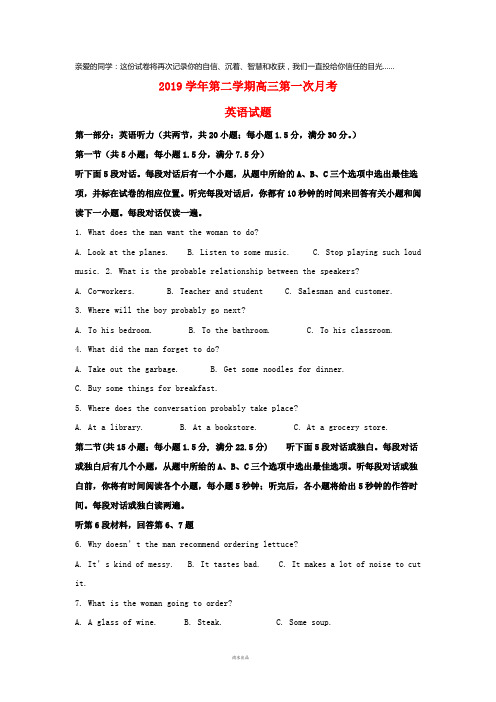
亲爱的同学:这份试卷将再次记录你的自信、沉着、智慧和收获,我们一直投给你信任的目光……2019学年第二学期高三第一次月考英语试题第一部分:英语听力(共两节,共20小题;每小题1.5分,满分30分。
)第一节(共5小题;每小题1.5分,满分7.5分)听下面5段对话。
每段对话后有一个小题,从题中所给的A、B、C三个选项中选出最佳选项,并标在试卷的相应位置。
听完每段对话后,你都有10秒钟的时间来回答有关小题和阅读下一小题。
每段对话仅读一遍。
1. What does the man want the woman to do?A. Look at the planes.B. Listen to some music.C. Stop playing such loud music. 2. What is the probable relationship between the speakers?A. Co-workers.B. Teacher and studentC. Salesman and customer.3. Where will the boy probably go next?A. To his bedroom.B. To the bathroom.C. To his classroom.4. What did the man forget to do?A. Take out the garbage.B. Get some noodles for dinner.C. Buy some things for breakfast.5. Where does the conversation probably take place?A. At a library.B. At a bookstore.C. At a grocery store.第二节(共15小题;每小题1.5分, 满分22.5分) 听下面5段对话或独白。
2019学年高二英语下学期月考试题人教版新版
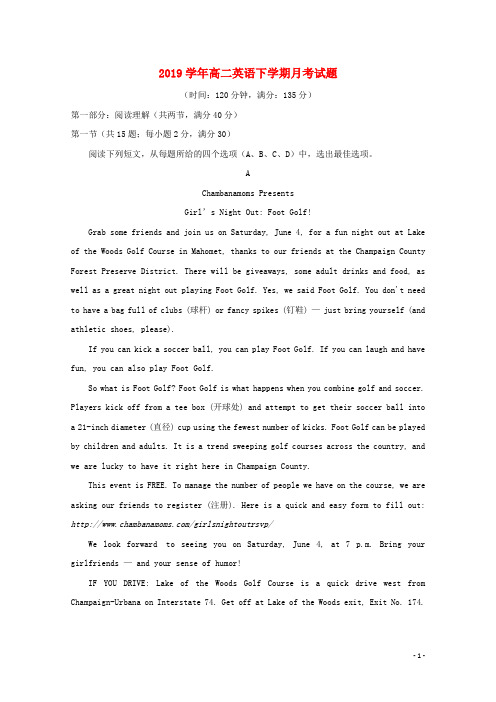
2019学年高二英语下学期月考试题(时间:120分钟,满分:135分)第一部分:阅读理解(共两节,满分40分)第一节(共15题;每小题2分,满分30)阅读下列短文,从每题所给的四个选项(A、B、C、D)中,选出最佳选项。
AChambanamoms PresentsGirl’s Night Out: Foot Golf!Grab some friends and join us on Saturday, June 4, for a fun night out at Lake of the Woods Golf Course in Mahomet, thanks to our friends at the Champaign County Forest Preserve District. There will be giveaways, some adult drinks and food, as well as a great night out playing Foot Golf. Yes, we said Foot Golf. You don't need to have a bag full of clubs (球杆) or fancy spikes (钉鞋) —just bring yourself (and athletic shoes, please).If you can kick a soccer ball, you can play Foot Golf. If you can laugh and have fun, you can also play Foot Golf.So what is Foot Golf? Foot Golf is what happens when you combine golf and soccer. Players kick off from a tee box (开球处) and attempt to get their soccer ball into a 21-inch diameter (直径) cup using the fewest number of kicks. Foot Golf can be played by children and adults. It is a trend sweeping golf courses across the country, and we are lucky to have it right here in Champaign County.This event is FREE. To manage the number of people we have on the course, we are asking our friends to register (注册). Here is a quick and easy form to fill out: /girlsnightoutrsvp/We look forward to seeing you on Saturday, June 4, at 7 p.m. Bring your girlfriends — and your sense of humor!IF YOU DRIVE: Lake of the Woods Golf Course is a quick drive west from Champaign-Urbana on Interstate 74. Get off at Lake of the Woods exit, Exit No. 174.Head north for ½ mile until the first stop sign. Take a left at the stop sign and travel for one mile. This road will take you directly to the golf course.1. Participants who come to Girl's Night Out __________.A. should wear athletic shoesB. need to bring spikesC. should bring their own clubsD. have to bring drinks and food2. What do we know about Foot Golf ?A. It is played worldwide.B. It is intended for children.C. It is a mixture of golf and soccer.D. It is nothing like playing golf.3. What type of writing is this text?A. An advertisement.B. A lesson plan.C. An educational report.D. An introduction to a sport.BIt was an extremely hot day. My younger brother Walt and I had decided to go swimming in the stream behind Mr. Blickez’s house, because it would be the only way to cool ourselves down. Across his farm and through some woods was a deep swimming hole supplied by several cold springs(泉).The only problem with our plan was that this farm was guarded by a huge mean Hereford bull(公牛). Mr. Blickez had told us that Elsie, the animal’s name, was the meanest bull in town, maybe even the county, and we believed in him. But the hotter it got, the more we thought there was reason to doubt about what he said. For one thing, we remembered Mr. Blickez liked telling tall tales; for another, Elsie seemed like a strange name for a bull. Finally, I talked Mom into asking permission for us to walk through the farm, and Mr. Blickez finally agreed.On our way across the farm, we stopped at the fence to admire the swimming hole. The sun shone brightly across the cool waters. We couldn’t wait to get there. Suddenly, Walt shouted loudly. Elsie had run to him and was licking (舔) his back. I immediately hid under the fence. However, when I looked up, I saw that Elsie wasn’t a big mean bull at all. She was just a friendly young cow, and she was going to keep lickingmy brother’s back as long as he stood still.When we discovered the truth, we were so happy. We then ran to the swimming hole and jumped in. The water was just as wonderful as we had dreamed. After that day, we had many good days and we often visited our secret swimming hole guarded by the so-called “big mean bull”.4. The author and his brother decided to go to swim because __________.A. there was no water to take a shower at homeB. they wanted to try their newly-found swimming holeC. Mr. Blickez invited them to his house for swimmingD. the weather was so hot that they couldn’t stand it5. What was the problem faced by the author and his brother?A. They didn’t know where to swim.B. Their mother didn’t want them to swim.C. They had to face a very mean bull.D. They didn’t know how to get to the stream.6. What can we know about Mr. Blickez?A. He is very shy.B. He often tells lies.C. He is an honest man.D. He is very kind to children.7. When Elsie saw the author’s brother, she __________.A. tried to attack himB. showed her friendlinessC. immediately ran awayD. tried to drive him awayCThere are around 6,000 living languages in the world —and at least half of these are in danger. In every part of the world, languages are disappearing. In fact, one scientist has said that languages are in more danger of extinction than birds or mammals. Professor Steve Sutherland of the University of East Anglia says that in the past 500 years 4.5 percent of languages have died out —compared with 1.3 percent of birds, and 1.9 percent of mammals.Languages come and go, and thousands have done exactly that without leaving any trace (痕迹). Only a very few — Basque, Greek and Latin among them — have lasted more than 2,000 years. But it seems that the pace of their disappearance is becoming quicker.The Ethnologue, a database of all the languages spoken in the world, states that 417 languages are spoken by so few people that they are in the final stages of becoming extinct. If very few people speak a language, it will probably die out.Languages may be lost through migration (迁移), as people move from small towns to city centers, or when environments are destroyed by the search for oil or wood. Natural disasters can also devastate populations, and along with them, their language. Governments also play a role in the extinction of languages. The need to establish “official languages”, for a country to educate its children and carry out its business, had a disastrous effect on many small languages.What is lost if a language is lost? Some people argue that languages die as the human race develops. Obviously there could be great benefits if everyone in the world spoke the same language — some industries already reflect (反映) this, with English essential for pilots and air traffic controllers. But there are more important things than convenience. As languages are lost, whole ways of life and knowledge may be lost along with them.To put it simply, language expresses something about identity, about our place in the world. Ani Rauhihi, a Maori teacher in New Zealand's North Island, sums it up: “If you grow up speaking our language, you won't know who you are.”8. The numbers mentioned in the first paragraph suggest that __________.A. most languages have died out completelyB. languages are disappearing slower than beforeC. animals are disappearing faster than languagesD. languages are in great danger of extinction9. The underlined word “devastate” can best be replaced by “__________”.A. increaseB. controlC. improveD. damage10. If a language is lost, __________.A. there will be great troubleB. its culture and knowledge will also be lostC. there is no need to worry about itD. people will be able to communicate with others conveniently11. What can we infer from the last paragraph?A. Languages reflect our identity.B. People will speak the same language one day.C. Fewer people will remember their own languages.D. Ani Rauhihi cares less about languages dying out.DImagine, one day, getting out of bed in Beijing and being at your office in Shanghai in only a couple of hours, and then, after a full day of work, going back home to Beijing and having dinner there.Sounds unusual, doesn't it? But it's not that unrealistic, with the development of China’s high-speed railway system. China has an even greater high-speed railway plan to connect the country with Southeast Asia, and finally Eastern Europe.China is planning to extend(延长) its own high-speed railway network to up to 17 countries in 10 to 15 years, eventually reaching London and Singapore.If China’s plan for the high-speed railway goes forward, people could rush from London to Beijing within two days. The new system would still follow China’s high-speed railway standard. And the trains would be able to go 346 kilometers an hour, almost as fast as some airplanes.China’s bullet train(高速列车), the one connecting Wuhan to Guangzhou, already has the World’s fastest average speed. It covers 1,069 kilometers in about three hours.Of course, there are some technical challenges to overcome. There are so many issues that need to be settled, such as safety and maintenance(保养) of railway tracks.So, it’s important to pay attention to every detail. But the key issue is really money. China is already spending hundreds of billions of yuan on longer railway construction.China prefers that the other countries provide natural resources rather than financial investment. Resources from those countries could flood into China to support development.It’ll be a win-win project. For other countries, the railway network will certainly create more opportunities for business, tourism and so on, not to mention the better communication among those countries.For China, such a project would not only connect it with the rest of Asia and bring some much-needed resources, but would also help develop China’s far west. We predict that in the coming decades, millions of people will move to the western parts, where the land is empty and resources unused. With high-speed trains, people will set up factories and business centers in the west. And they’ll trade with Central Asian and Eastern European countries.12. According to the passage, the greatest challenge to the new high-speed railway plan __________.A. financial problemsB. safety of the systemC. technical issuesD. maintenance of railway tracks13. What’s the author’s attitude towards China’s high-speed railway plan?A. PositiveB. NegativeC. DoubtfulD. Critical14. China’s new high-speed railway plan will be a win-win project because __________.A. China and the countries involved will get much-needed resourcesB. China and the countries involved will benefit from the project in various waysC. China will develop its railway system and communication with other countriesD. foreign countries involved will develop their railway transportation, business and tourism15. Which of the following might be the best title for the passage?A. International Railway NetworkB. High-speed Bullet TrainsC. Big Railway DreamsD. New Railway Standards第二节(共5题;每小题2分,满分10分)根据短文内容,从短文后的选项中选出能填入空白处的最佳选项。
2019学年高二英语下学期第三次月考试题 人教 新目标版
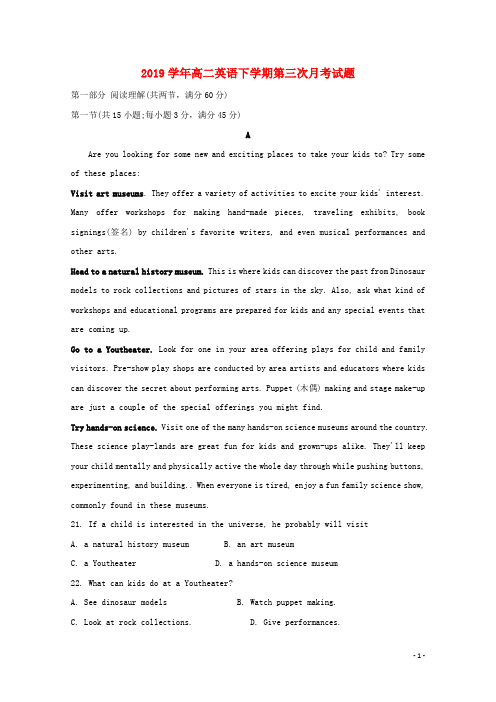
2019学年高二英语下学期第三次月考试题第一部分阅读理解(共两节,满分60分)第一节(共15小题;每小题3分,满分45分)AAre you looking for some new and exciting places to take your kids to? Try some of these places:Visit art museums. They offer a variety of activities to excite your kids' interest. Many offer workshops for making hand-made pieces, traveling exhibits, book signings(签名) by children's favorite writers, and even musical performances and other arts.Head to a natural history museum.This is where kids can discover the past from Dinosaur models to rock collections and pictures of stars in the sky. Also, ask what kind of workshops and educational programs are prepared for kids and any special events that are coming up.Go to a Youtheater. Look for one in your area offering plays for child and family visitors. Pre-show play shops are conducted by area artists and educators where kids can discover the secret about performing arts. Puppet (木偶) making and stage make-up are just a couple of the special offerings you might find.Try hands-on science. Visit one of the many hands-on science museums around the country. These science play-lands are great fun for kids and grown-ups alike. They'll keep your child mentally and physically active the whole day through while pushing buttons, experimenting, and building.. When everyone is tired, enjoy a fun family science show, commonly found in these museums.21. If a child is interested in the universe, he probably will visitA. a natural history museumB. an art museumC. a YoutheaterD. a hands-on science museum22. What can kids do at a Youtheater?A. See dinosaur modelsB. Watch puppet making.C. Look at rock collections.D. Give performances.23. What does "hands-on science" mean in the last paragraph?A. Learning science by doing thingsB. Science games designed by kidsC. A show of kids' science workD. Reading science books.24. Where does this text probably come from?A. A science textbook.B. A tourist map.C. A museum guide.D. A news report.BThe most common problem that worries all of us today is the fear of insecurity (不安全). Life has become so competitive that every now and then we are struck (遭遇) by the fear of the unknown. With every new turn of events our self-confidence takes a blow. The biggest challenge before every person today is not to lose confidence in one’s ability.There are several reasons that affect a person’s self-confidence. The most important reason is lack of success. Not being a ble to succeed affects one’s self-confidence greatly. This is when one begins to doubt his own ability. In many cases one’s self-confidence is low when he feels rejectedby society. For example, a person who loses his job gives a wide berth to other people for fear of being questioned about his work. However, this isn’t right at all. One needs to think along positive lines in spite of failures. After all it is your life and you have every right to live your life as you wish.The challenge lies in not allowing your self-confidence to decrease. It is very important to believe in yourself. Self belief is the secret to success. When success doesn’t come to you, you should not allow your self-belief to be affected. Always keep in mind that success is sure to come in time. So, there is nothing wrong with your ability. Whenever lack of success causes you to doubt your ability, don’t forget to remind yourself that quick success does not last long. Also remember not to compare yourself to others. These tips will do a world of good to your confidence.In order to be self-confident, you need to have a lifestyle that is right for you. Create one and live a life as you want to. Leave others to themselves.25. According to the text, what causes people to fear the unknown?A. The low abilities.B. The lack of security.C. The loss of self-confidence.D. The severe competition in life.26. What does the underlined phrase “give a wide berth to” in Paragraph 2 mean?A. Introduce something to.B. Hold a birthday party for.C. Make friends with.D. Keep away from.27. What’s Paragraph 3 mainly about?A. How to achieve success.B. How to keep one’s self-confidence.C. The challenges that one should overcome.D. The reasons that affect o ne’s self-confidence.28. In the author’s opinion, it’s important that one _____.A. should not forget his failuresB. should follow others’ adviceC. should not lose heartD. should believe lifeCAmmie Reddick from East Kilbride, Lanarkshire, was only 18 months old when she had the accident that had scarred(留下创伤) her for life. The curious child reached up to grab the wire of a hot kettle in the family kitchen and poured boiling water over her tiny infant frame.Her mother Ruby turned round and, seeing Ammie horribly burnt, called an ambulance which rushed her daughter to a nearby hospital. Twenty percent of Ammie’s body had been burned and all of her burns were third-degree. There, using tissue(组织) taken from unburned areas of Ammie’s body, doctors performed complex skin transplants to close her wounds and control her injuries, an operation that took about six hours. Over the next 16 years, Ammie underwent 12 more operations to repair her body.When she started school at Maxwelton Primary at age 4, other pupils made cruel comments or simply wouldn’t play with her. “I was the only burned child in the street, the class and the school,” she recalled, “some children refused to become friends because of that.”Today, aged 17, Ammie can only ever r emember being a burned person with scars; pain is a permanent part of her body. She still has to have two further skin transplants. Yet she is a confident, outgoing teenager who offers inspirationand hope to other young burns victims.She is a member of t he Scottish Burned Children’s Club, a charity set up last year. This month, Ammie will be joining the younger children at the Graffham Water Center in Cambridge shire for the charity’s first summer camp. “I’ll show them how to get rid of unkind stares from others,” she says. Ammie loves wearing fashionable sleeveless tops, and she plans to show the youngsters at the summer camp that they can too. “I do not go to great lengths to hide my burns scars,” she says, “I gave up wondering how other people would react years ago.”29.What did other children do when Ammie first went to school?A.They were friendly to her. B.They showed sympathy to her. C.They were afraid of her. D.They looked down upon her.30. Ammie will teach the younger children at the Graffham Water Center to___________. A.face others’ unkindness bravely B.hide their scars by proper dressing C.live a normal life D.recover quickly31. What does the underlined word “permanent” in the 4th pa ragraph mean?A. necessaryB. life-longC. difficultD. important32. What can be the best title of the passage?A.A Seriously Burned Girl Survives B.Ways to Get Rid of Unkind Stares C.Permanent Scars And Pain For a Girl D.A Seriously Burned Angel of HopeDHalf the world’s population could face a shortage of food by 2100 due to climate change, a new report by US scientists warns. Rapid global warming is likely to reduce crop production in the tropics and subtropics, according to Professor David Battisti of the University of Washington.The most extreme summers of the last century will become common, he says. We must immediately create crops that can bear heat and drought if we are to adapt in time, he writes in Science journal.“The stresses on global food production from temperature alone are going to be huge,” said MrBattisti. “And that doesn’t take into account water supplies stressed by the higher temperatures.”He worked with Professor Rosamond Naylor on Food Security and the Environment, to examine the influence of climate change on the world’s food supplies. They predict there is a greater than 90% probability that by 2100, the average growing-season temperatures in the tropics and subtropics will be higher than any temperatures recorded there to date.“We are taking the worst of what we’ve seen historically and saying that in the future it is going to be a lot worse unless there is some kind of adaptation,”said Professor Naylor. “This is a powerful reason for us to invest in adaptation, because it is clear that this is the direction we are going in terms of temperature and it will take decades to develop new food crop varieties that can better bear a warmer climate.”In the tropics, the higher temperatures could be expected to cut production of the primary food crops by 20-40%, the researchers said. Rising temperatures are also likely to reduce soil moisture (湿度), cutting production even further.Three billion people live in the tropics and subtropics now, and their number is expected nearly to double by the end of the century.“You are talking about hundreds of millions of additional people looking for food because they won’t be able to find it where they find it now,” said Professor Battisti.Crop failures would not be limited to the tropics, the scientists concluded.33. According to Professor David Battisti, what should be done to deal with crops reduction caused by global warming?A. To plant more crops.B. To develop new crops.C. To control population growth.D. To improve farming technology.34. What does the underlined word “this” in Paragraph 5 refer to?A. To reduce the temperature.B. New food crop varietyC. To invest in adaptation.D. Some kind of adaptation.35. The text intends to tell us that _____.A. our world is becoming warmer and warmerB. high temperatures may cause food shortagesC. the consequences of global warmingD. the ways to adapt to high temperatures第二节(共5小题;每小题3分,满分15分)根据短文内容,从短文后的选项中选出能填入空白处的最佳选项。
精品2019学年高二英语11月月考试题三 新版 新人教 版
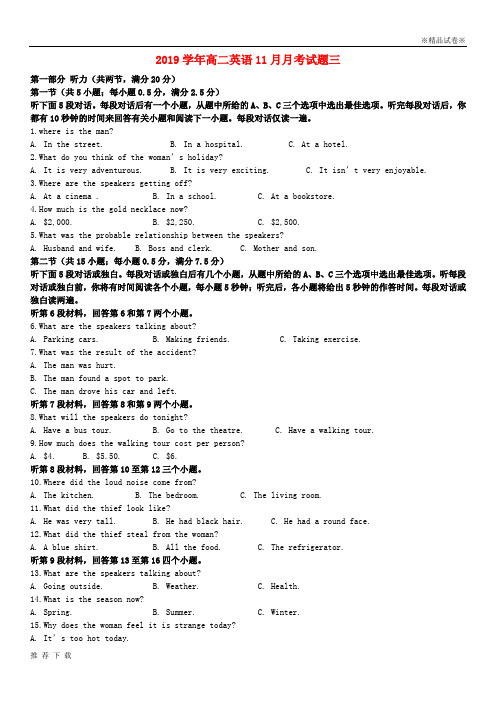
2019学年高二英语11月月考试题三第一部分听力(共两节,满分20分)第一节(共5小题;每小题0.5分,满分2.5分)听下面5段对话。
每段对话后有一个小题,从题中所给的A、B、C三个选项中选出最佳选项。
听完每段对话后,你都有10秒钟的时间来回答有关小题和阅读下一小题。
每段对话仅读一遍。
1.where is the man?A. In the street.B. In a hospital.C. At a hotel.2.What do you think of the woman’s holiday?A. It is very adventurous.B. It is very exciting.C. It isn’t very enjoyable.3.Where are the speakers getting off?A. At a cinema .B. In a school.C. At a bookstore.4.How much is the gold necklace now?A. $2,000.B. $2,250.C. $2,500.5.What was the probable relationship between the speakers?A. Husband and wife.B. Boss and clerk.C. Mother and son.第二节(共15小题;每小题0.5分,满分7.5分)听下面5段对话或独白。
每段对话或独白后有几个小题,从题中所给的A、B、C三个选项中选出最佳选项。
听每段对话或独白前,你将有时间阅读各个小题,每小题5秒钟;听完后,各小题将给出5秒钟的作答时间。
每段对话或独白读两遍。
听第6段材料,回答第6和第7两个小题。
6.What are the speakers talking about?A. Parking cars.B. Making friends.C. Taking exercise.7.What was the result of the accident?A. The man was hurt.B. The man found a spot to park.C. The man drove his car and left.听第7段材料,回答第8和第9两个小题。
- 1、下载文档前请自行甄别文档内容的完整性,平台不提供额外的编辑、内容补充、找答案等附加服务。
- 2、"仅部分预览"的文档,不可在线预览部分如存在完整性等问题,可反馈申请退款(可完整预览的文档不适用该条件!)。
- 3、如文档侵犯您的权益,请联系客服反馈,我们会尽快为您处理(人工客服工作时间:9:00-18:30)。
2019学年第二学期高三第一次月考英语试题第一部分:英语听力(共两节,共20小题;每小题1.5分,满分30分。
)第一节(共5小题;每小题1.5分,满分7.5分)听下面5段对话。
每段对话后有一个小题,从题中所给的A、B、C三个选项中选出最佳选项,并标在试卷的相应位置。
听完每段对话后,你都有10秒钟的时间来回答有关小题和阅读下一小题。
每段对话仅读一遍。
1. What does the man want the woman to do?A. Look at the planes.B. Listen to some music.C. Stop playing such loud music. 2. What is the probable relationship between the speakers?A. Co-workers.B. Teacher and studentC. Salesman and customer.3. Where will the boy probably go next?A. To his bedroom.B. To the bathroom.C. To his classroom.4. What did the man forget to do?A. Take out the garbage.B. Get some noodles for dinner.C. Buy some things for breakfast.5. Where does the conversation probably take place?A. At a library.B. At a bookstore.C. At a grocery store.第二节(共15小题;每小题1.5分, 满分22.5分) 听下面5段对话或独白。
每段对话或独白后有几个小题,从题中所给的A、B、C三个选项中选出最佳选项。
听每段对话或独白前,你将有时间阅读各个小题,每小题5秒钟;听完后,各小题将给出5秒钟的作答时间。
每段对话或独白读两遍。
听第6段材料,回答第6、7题6. Why doesn’t the man recommend ordering lettuce?A. It’s kind of messy.B. It tastes bad.C. It makes a lot of noise to cut it.7. What is the woman going to order?A. A glass of wine.B. Steak.C. Some soup.听第7段材料,回答第8、9题。
8. Who is the woman probably speaking to?A. A waiter.B. A doctor.C. A teacher.9. What is the man’s advice?A. Looking for a new job.B. Stopping drinking any coffee.C. Making sure to have breakfast.听第8段材料,回答第10至12题。
10. Where are the speakers going to sleep?A. In a cabin.B. By the water.C. At the meeting point.11. Who introduced the man to the location?A. His father.B. His uncle.C. His brother.12. Where will the speakers get water?A. From the other guys.B. From the car.C. From the river.听第9段材料,回答第13至16题。
13. What does the man want the woman to do at first?A. Help him study.B. Introduce him to a driver.C. Give him a ride to the airport.14. When does the man’s flight take off?A. On Sunday morning.B. On Monday morning.C. On Wednesday afternoon.15. How do the speakers know each other?A. They’re neighbors.B. They’re classmates.C. They’re co-workers.16. What will the man do next?A. Make a call to the woman’s neighbor.B. Find a parking lot in the neighborhood.C. Ask his neighbor to do him a favor.听第10段材料,回答第17至20题。
17. Why was the morning unusual for Amber?A. She reported a crime.B. She was late for work.C. She didn’t send her son to school.18. What did Amber see the large man doing?A. Knocking on a door.B. Talking with the police.C. Running after a cat.19. Who let the cat out?A. Frank.B. Amber.C. The Stevensons.20. How does Amber probably feel at the end of the story?A. Amused.B. Confused.C. Embarrassed.第二部分:阅读理解(共两节,20小题;每小题 2 分,满分 40分)第一节(共15小题;每小题2分,满分30分AWhen you travel in South America, you'd better pay attention to the following three kinds of dangerous South American animals.Piranhas (水虎鱼)Although only a small number of piranhas are considered to be dangerous to humans, the red-bellied piranha is definitely one of those. Evidence has shown that a large group of piranhas can absolutely eat a herd of large animals crossing the river, leaving only bones. This fish lives in the freshwater streams of South America, and they can smell the blood from far away and launch attacks swiftly. It is said that they are only dangerous to humans if the water volumes are less and lower.Anacondas (水蟒)This South American monster of a creature often appears in the films or your nightmares! They have weighed over 230 kilograms. It is often considered to be the biggest snake in the world. You certainly don’t want to get caught alone with this snake due to its method of attacking and killing its victim. It is indeed a remarkably different brand of snake type as it regularly coils (缠绕) around all over its target, increasing the pressure until eventually its victim dies. Its jaws are powered by large muscles that produce enough power for its over 100 sharp teeth to pass through the thick skin of an crocodile. They don't have poison. Sometimes they prefer to camouflage themselves so they look like their surroundings and swiftly draw back when humans are near.Golden Poisonous FrogsThe golden poison from might be the most-deadly of the South American animals, which is protected by means of poison. This very small frog, less than 55 mm in length, packs enough punch (效力)to take down of African bull elephants. This apparently harmless frog has always been known to have killed people who have tou ched it directly. It’s also been noted that chicken and dogs have died by connecting things on which a golden poison frog had wandered! In intense colors, they normally look attractive to their targets.1. What can we learn about piranhas from the passage?A. Piranhas are the most dangerous animals.B. Piranhas like to live in the deep seabed.C. Piranhas may attack human beings when the water level is lowD. Piranhas only attack human beings when they cross the river in groups2. How does an anaconda kill its victim according to the passage?A. It often uses its poison to kill its victim.B. It often uses its strength to kill its victim.C. It kills its victim mainly using its powerful teeth.D. It kills its victim with the help of other snakes.3. The unde rlined word “camouflage” in Paragraph 3 means “”.A. hide itself by appearing like the surroundingsB. terrify and capture the enemy by making much noiseC. move around to search for delicious foodD. give off harmful gas to kill the targets4. Chicken and dogs are mentioned in Paragraph 4 to show that .A. no animals can survive the poison of the golden poison frogB. they like to wander along the path of the golden poison frogC. the golden poison frog likes eating them mostD. the poison of the golden poison frog is deadly【答案】1. C 2. B 3. A 4. D【解析】试题分析:本文描述了南美三种危险的动物:水虎鱼,水蟒和金毒蛙。
